The whole point of a well water filter is to remove contaminants from your water, so it’s normal for the filter to look a bit dirty after a while. But a well water filter that’s turning black is a bit more disturbing.
In this guide, we’ve shared the most common reasons why your well filter might turn black, and the best ways to resolve the issue.
📌 Key Takeaways
- It’s normal for a well water filter to become dirty over time, but if the filter turns black, you’re probably dealing with an issue beyond simple contamination.
- Common causes of a black well water filter are iron, manganese, mold, rust, and silt in water.
- Issues with your well’s construction, a new well, a leaking septic tank, and an old filter all increase the likeliness of black coloration of the water filter.
- The best way to prevent your well filter from turning black is to test your water, install an additional filter stage if needed, and get your well inspected.
Table of Contents
🔎 What Makes a Well Water Filter Turn Black?
There are several different reasons why your well water filter might appear to be turning black.
As water passes through the filter, the contaminants in the water are trapped in the filter media. That’s a normal part of the filtration process – but if you have particularly dirty water, you might end up with a black cartridge filter.
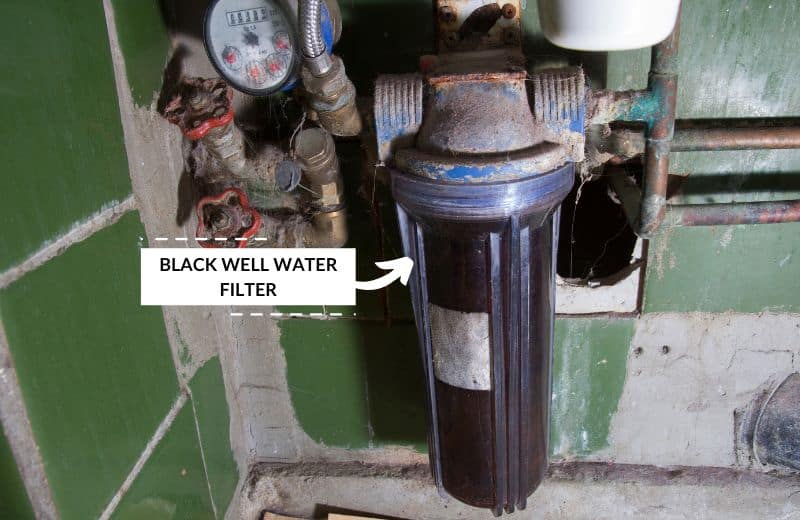
If you’re uncertain why your filter is black, look into the following possibilities:
Water Quality Issues
Below, you’ll find a list of water quality issues that most often lead to black staining in your well filter.
1) Iron or Manganese
Iron and manganese are two well water contaminants that are most likely to be responsible for brown or black stains on your well water filter.
While iron is an essential nutrient – and so is manganese, though in a smaller amount – these metals can be dangerous in excess.
You can’t usually tell from looking at your water that it contains these contaminants, but you may notice an orange tint when your water is exposed to oxygen.
2) Mold
After iron and manganese, mold is the second-most likely cause of a black whole house water filter cartridge.
Damp, warm environments are prone to mold accumulation. You shouldn’t notice mold buildup if you install your filter in a cool, dark location – unless you’ve left it too long between filter replacements.
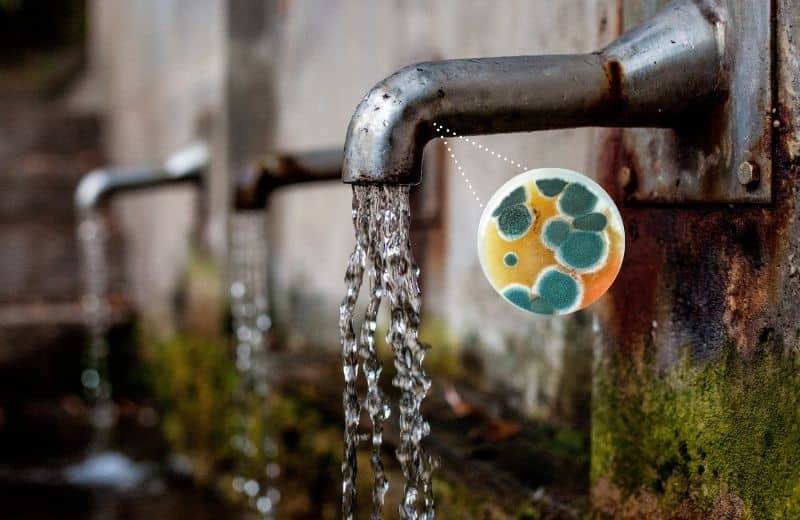
3) Silt or Sand
Silt, sand, dirt, and other types of sediment may also build up in your whole house water filter, giving it a black or brown color.
Most wells don’t have enough sediment to cause black or brown coloration – it depends on where the well is located.
4) Rust
If your plumbing upstream of the filter system is rusty, it’s possible that your whole house water filter black coloration is caused by rust deposits.
Old plumbing made from iron is most likely to be susceptible to corrosion and rusting. Unfortunately, if one segment of your plumbing is rusty, it’s likely that all the plumbing in your home is rusty, leading to expensive replacement costs.
Related: How to get rid of rust in well water.
5) Mud and Soil
Mud and soil might be getting into your well water if you have a well construction flaw (more on that below). Your filter should be able to successfully remove these contaminants from your water, but the cartridge might need changing more frequently.
Learn more about how to filter muddy well water.
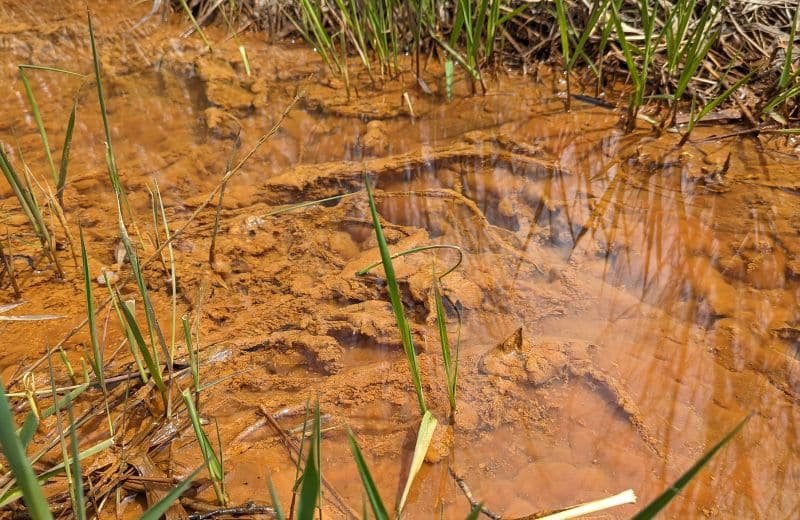
6) Animal Waste
In a worst-case scenario, poor well construction or location too near to a septic system could cause animal or human waste to get into your well water.
If this isn’t removed prior to entering your home, it’ll end up getting into your whole house’s water filter cartridges, staining them brown or black.
Well System Issues
Here, we’ve shared the most common issues with your well system itself, which may lead to a black water filter.
7) Improper Well Construction
A poorly constructed well, a well that isn’t properly drilled, or a well installed in the wrong location, may allow excess contaminants to seep in from the surrounding rocks and soils.
These contaminants might be able to slip through the well screen and become trapped in your whole house water filter system, causing the filters to turn black.
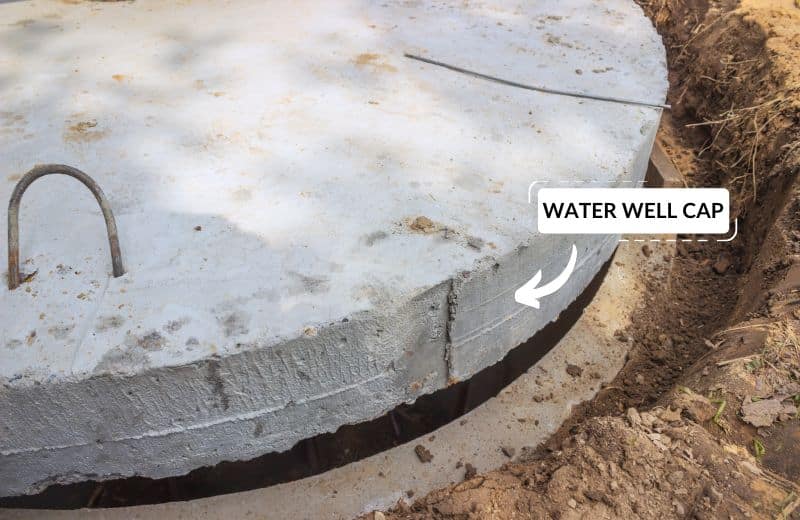
8) Well Screen Damage
The role of a well screen is to allow water to enter the well casing through the aquifer. A damaged or worn well screen may allow unwanted contaminants to enter the well system, eventually reaching your whole house water filter, where they become trapped.
9) A New Well
A new, freshly-drilled well may produce a small amount of sediment for the first few weeks, due to a disturbance of the soil around the well.
This sediment may clog up the filters in your well water treatment system. The problem should remedy itself within a month or so.
10) Well Pump Problems
An incorrectly installed or malfunctioning well pump could suck up excess black sediment. Once in your water supply, this sediment would become trapped in your whole house water filter media, changing the filter’s color.
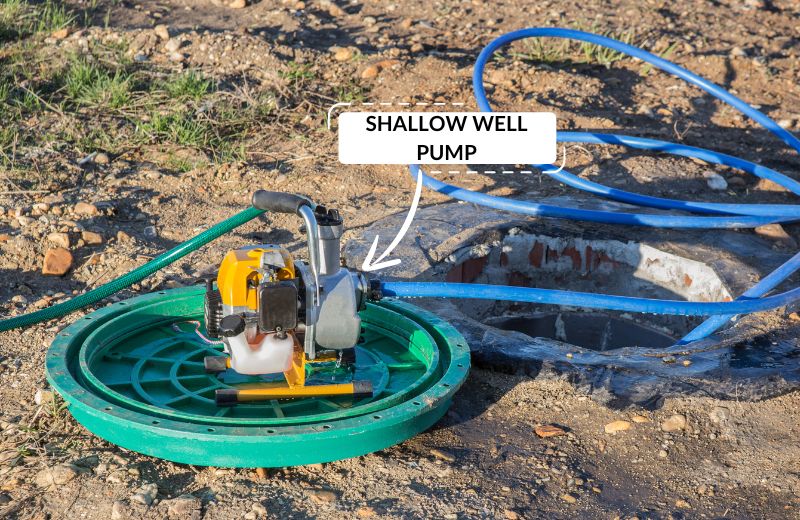
11) Collapsed Well
A particularly old or poorly constructed well could collapse. Earthquakes, flooding, and other natural disasters may also cause the walls of your well to collapse, allowing contaminants to seep into your well water supply.
A visual inspection may not be enough to detect a collapsed well, so contact your local well contractor if you’re concerned.
Water Filter Issues
Finally, let’s look at issues with the water filter itself that could be causing it to turn black.
12) Carbon Particles
If you treat your water with some kind of carbon filter, such as a granular activated carbon filter, some of the carbon particles from the filter might have become dislodged, causing them to leak into your water supply and giving the appearance of black sediment.
This is especially likely in new filters that haven’t been properly flushed before use.
13) Old Filter
It’s pretty normal for all filters to accumulate particles of all different colors over their months of use, including black particles.
So, if your filter has turned an impressive shade of black, you may simply need to replace it with a new one. Replacing your filter will also reduce the likelihood of mold buildup.
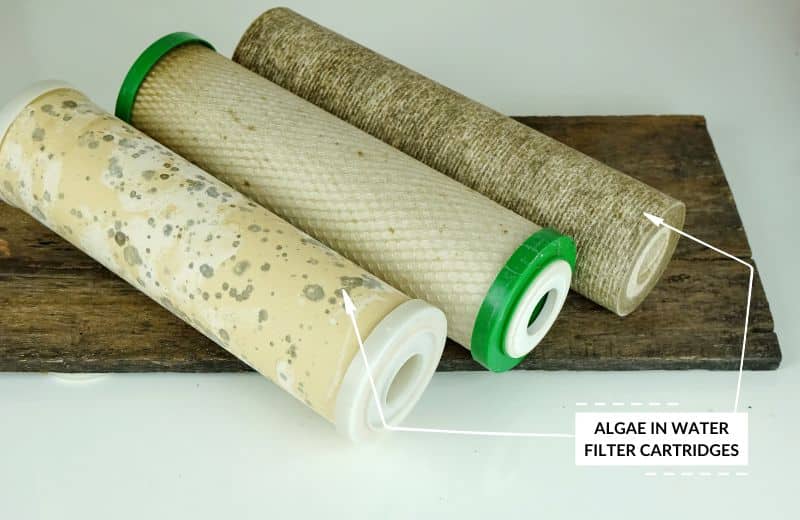
🧰 How to Fix A Black Well Water Filter
Below, we’ve outlined the steps to take to fix your black well water filter, depending on the cause of the problem.
Test Your Water
First thing’s first, find out what your water contains. Get your water tested to determine the most likely cause of black particles in your well water filter.
As we mentioned earlier, some of the common causes of black coloration in your water filters are sediment, iron, manganese, carbon granular particles, and black sand. Most of these contaminants can be removed from your water – but only with the right type of filter.
That’s why it’s useful to test your water, so you know exactly which water filters will target the problem contaminants.

Replace The Filter
Even the best drinking water filter has a limited lifespan.
You’ll need to replace the filters in your well water filtration system regularly to prevent a buildup of mold, sediment, and other black stuff, which will reduce the effectiveness of filtration and potentially introduce harmful contaminants into your water.
Replacing the filter as recommended by the manufacturer may be all it takes to keep a buildup of black mineral deposits at bay.
This guide explains exactly how often a well water filter should be replaced.
Install Additional Filter Stages
Perhaps your current filtered water system can’t handle the contaminants your well water contains. In that case, you’ll need to install a water filter that can.
Some of the additional filter systems to consider, depending on your water quality, are:
Sediment Filter
Sediment filters are perhaps the most essential filters for well water, since black sediment in well water is so common.
It’s best to use this type of filter as a pre-filter stage, since it can only target particles of sand, dirt, rust, and other causes of muddy water – it can’t remove pathogens, chemicals, or heavy metals.
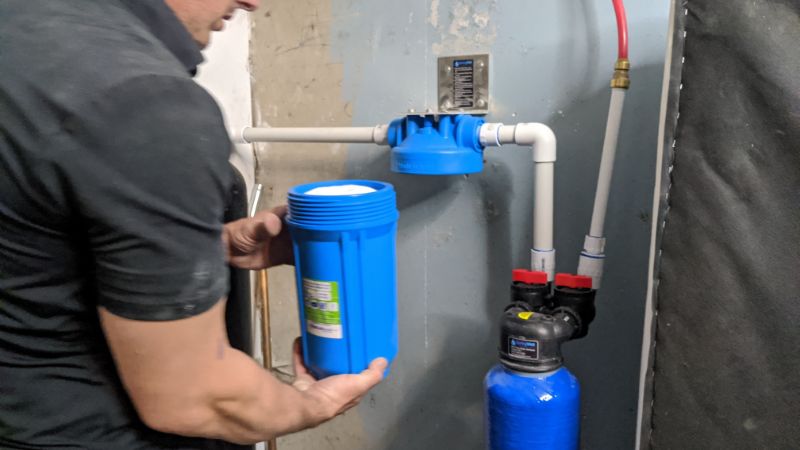
Sand Separator
Sand separators are designed to treat drinking water containing coarse sand. This filter – which is typically installed between the pump and the pressure tank – spins water quickly through the filter, separating the sand particles with centrifugal force.
We strongly recommend installing a sand separator if sand in your well water is a common occurrence.
Iron & Manganese Filter
Iron and manganese can’t be removed by most filter cartridges or sediment filters. Why? Because these contaminants are often dissolved in water, they can’t be physically trapped in a filter media.
If you have issues with iron and manganese staining, look for a chemical or air injection system, which oxidizes iron and manganese particles, changing them into a ferric form that can be physically removed (usually by birm or manganese greensand).
Shop for systems that can reduce iron down to 0.3 mg/L and manganese down to 0.05 mg/L, according to the National Secondary Drinking Water Regulations set by the U.S Environmental Protection Agency.
Continue Reading:
- Top Chemical Feed Pump Systems Reviewed
- Top Air Injection Oxidation (AIO) Systems Reviewed
- 8 Leading Well Water Filtration & Treatment Systems
📌 Note: You can also use a water softener system to remove low levels of dissolved iron (around 5 PPM) and low levels of manganese from the water. However, a water softener is not effective on its own for high levels of manganese or iron.
Inspect Your Well
Even if you think your well works fine, you should still get it inspected once a year to diagnose potential issues before they become a costly repair job.
Hire a professional well contractor to inspect your well at least once a year. They’ll assess the structure and cleanliness of your well, and test your water for common groundwater contaminants.
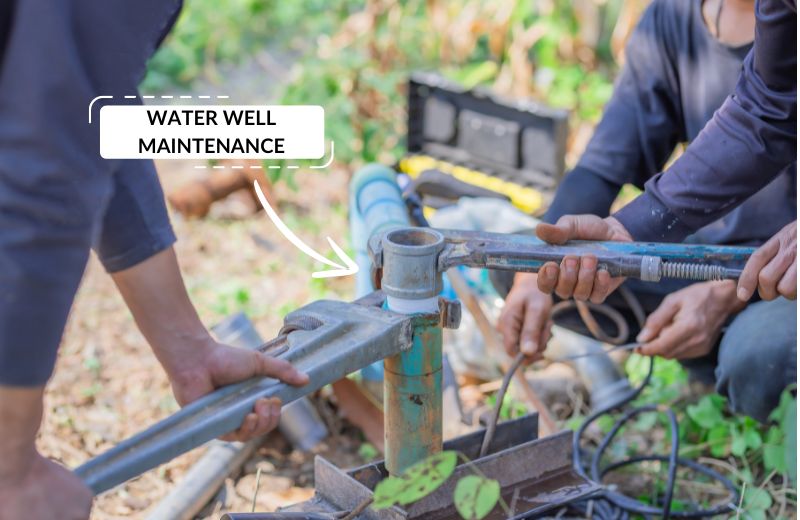
Inspect (And Fix) Your Septic System
If you use a private septic system that’s installed on your property, you’ll also need to inspect this system at least once a year and act immediately when necessary.
Because of the dangers of septic leaks, it’s best to take the preventative maintenance approach, rather than only getting the septic tank looked at when you suspect a problem.
Getting a professional to inspect your septic system regularly means you’ll never be caught by surprise by a potentially dangerous situation. Failing septic tanks should be fixed as soon as an issue is detected.
Replace Your Plumbing
If trapped iron particles & rust in your filter are caused by old, corroded plumbing and pipes, you may need to replace your entire plumbing system to protect your filtration cartridges in the long term.
📌 Don’t just look at your pipes – check your water heater, too. Old water heater units are also susceptible to corrosion, and may be responsible for your rusty water filter.
Replacing your plumbing is an expensive job, but it’s pretty essential – once water pipe corrosion begins, your pipes will only get worse over time. You’ll need to hire a professional to do this job for you.
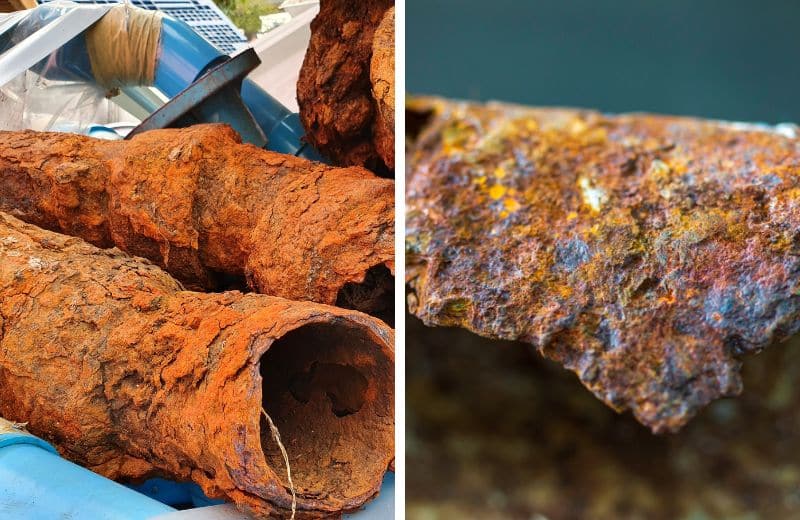
❔ Black Well Water Filter: FAQ
Why does my well filter turn black?
Your well filter might turn black due to a presence of black sediment in the water, or other contaminants that deposit black stuff on surfaces, like iron and manganese mineral deposits, animal and human waste, rust from water pipes, clay particles, and black sand.
How often should you replace a well water filter?
You should replace a well water filter every 3-12 months, on average. The lifespan of a well water filter depends on the type and size of the filter. For instance, spin-down sediment filter cartridges can be washed and reused, so they last much longer than cartridge-based sediment filters.
What are the black things in the water filter?
The black particles in a water filter could be one of several things: black sediment particles from your well water supply, black mold (suggesting you need to replace the filter), and black granular carbon particles (common in carbon filter cartridges).
What causes black slime in well water?
Black slime in a well water filtration system is usually caused by iron bacteria (formed when harmful bacteria feeds off iron). Changes to your well structure, such as drilling or repair work, can cause iron bacteria to enter your well water. You may need to shock your well to get rid of the iron bacteria, and treat any underlying issues that could be causing the contaminant to enter your water.
Is black sediment in well water dangerous?
No. Usually, black sediment in well water isn’t dangerous. However, black sediment will affect your water quality, may clog your whole house filter, and is likely to damage your plumbing system and hot water heater. That’s why it’s wise to get your water tested and find a filtration system that can remove black sediments before they cause too much harm in your home.
